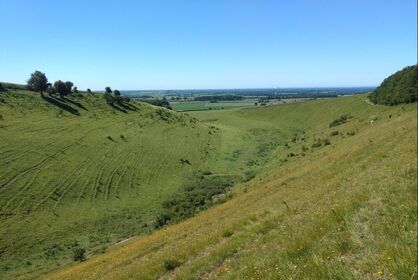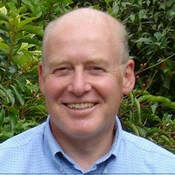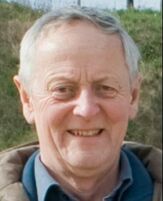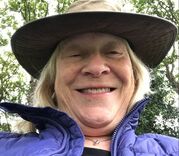History
|
The Trust was established on 1st August 1998 as the North and East Yorkshire Ecological Data Trust. The original board of Trustees comprised Peter Fattorini, Michael Thompson, Jack Lavin (Chair) and Jeffrey Lunn (Secretary).
By a Deed of Trust dated 18th January 2006 the name of the Trust was changed to the Yorkshire & Humber Ecological Data Trust (charity number 1075999). |
Jack C Lavin MBE - Obituary
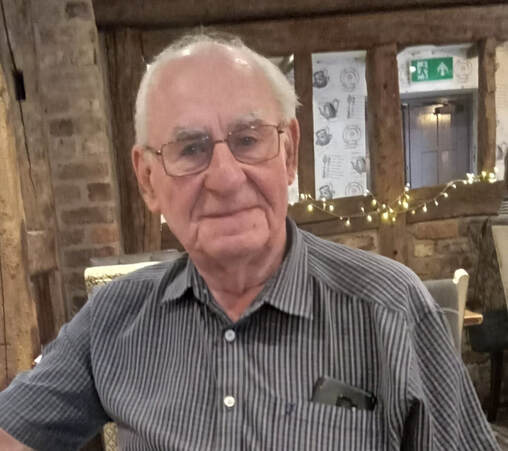 Jack C Lavin MBE 1938-2024
Jack C Lavin MBE 1938-2024
Jack worked at Blackburn Museum until 1966 when he moved to Cliffe Castle, which then belonged to Keighley Town Council which became part of Bradford Metropolitan District Council following the Local Authority reorganisation in 1974. It was here that Jack pioneered their Biological Records Centre where he persuaded elected members to allow him to set up the first Ecological Records Centre for West Yorkshire based at Cliffe Castle Museum.
Jack along with his colleague of more than 20 years Geoffrey Wilmore carried out extensive habitat surveys across West Yorkshire as well as establishing species recording and mapping the distribution of plant species across the county. As the information in the records centre grew, Jack developed the records centre into the Ecological Advisory Service (EAS) which continued to gather biological records, but also provided objective ecological advice regarding all planning issues in the county, supporting the Unitary Development Plan processes as well as acting as a consultee on ecological issues relating to individual planning applications.
Jack achieved a huge amount during his time at the EAS designing and organising several county wide surveys and surveying all semi-natural habitats in the county. Jack also established the first second tier nature conservation site system for West Yorkshire known as Sites of Scientific Interest (SSIs) – many of which are still extant, although now known as Local Wildlife Sites (LWS).
As well as providing important ecological data for West Yorkshire, the data Jack and Geoffrey gathered had additional value, not least providing quadrat information that was used as part of the National Vegetation Classification system developed by Dr John Rodwell at Lancaster University on behalf of the Nature Conservancy Council. In addition, the data was instrumental in germinating an idea in 1986, of producing species distribution maps of all species in West Yorkshire which was eventually published as the West Yorkshire Plant Atlas in 1994; the first major flora of West Yorkshire since FA Lees’ work The Flora of West Yorkshire in 1888.
Jack was awarded the Member of the Order of the British Empire (MBE) for his Services to Biology in 1991, not least for his input into a wide range of land reclamation, landscaping and habitat creation schemes, including the research and development of pioneering colliery spoil reclamation using sewage sludge, working closely with scientist Barbara Metcalf from Yorkshire Water.
Following his retirement from his career in the local authority and a chance meeting with Dr Mike Horner, he was persuaded to Join Bullen Consultants in Bradford, a 500 strong Civil Engineering design business to advise on the establishment and growth of an environmental business to support their flood engineering and highway design team, which he continued to do successfully until his retirement in 1998.
During the 1990s, Jeff Lunn who had transferred from West Yorkshire to working in North & East Yorkshire for English Nature, had recognised the value and effectiveness of the work that EAS and Jack were doing, and set up a Steering Group to try and establish a similar venture for North & East Yorkshire. After much effort, a feasibility study was commissioned from the Somerset Environmental Records Centre and authored by Bill Butcher, which recommended a new records centre. With Jack’s considerable knowledge and experience, he was commissioned by the Steering Group to start implementing the proposal and an innovative mechanism – a Trust – was set up to provide the vehicle. Jack’s close friend Peter Fattorini, Dr Michael Thompson, Jeff and Jack were inaugurated as the Trust’s first trustees and Jack was then proposed as the North & East Yorkshire Ecological Data Trust’s first Chairman. He went on to serve from 2000 to 2009, overseeing the Trust and its operating arm the North & East Yorkshire Ecological Data Centre.
Jack did not slowdown in his retirement. In addition to the various contracts he undertook such as with NEYEDC, he took up the cultivation of orchids with two greenhouses full of various tropical species, and joining the Harrogate orchid society eventually becoming Chairman. He also returned to an old passion of birdwatching with more time to travel widely in the UK with his wife Barbara visiting many RSPB reserves.
Andy Barker, a current Trustee of YHEDT and former colleague at the EAS, said, ‘Jack was a true mentor to me. His passion, enthusiasm, strength of character to do the right thing, humour and willingness to give someone with no experience but bags of energy and enthusiasm is something I shall always be grateful for and something I try to live up to in everything I do in my career.’
Jeff Lunn, the current Chairman, added, ‘ Jack was a great character and advocate for the natural environment. I warmly recall working with him on projects in West Yorkshire such as on the West Yorkshire Plant Atlas, and also as a dynamic colleague when we commissioned him to get the NEYEDC underway. The foundations that were laid down for the Trust and Centre to develop and flourish (as it does today) owe much to Jack’s enthusiasm and hard work in those early years.’
Jack along with his colleague of more than 20 years Geoffrey Wilmore carried out extensive habitat surveys across West Yorkshire as well as establishing species recording and mapping the distribution of plant species across the county. As the information in the records centre grew, Jack developed the records centre into the Ecological Advisory Service (EAS) which continued to gather biological records, but also provided objective ecological advice regarding all planning issues in the county, supporting the Unitary Development Plan processes as well as acting as a consultee on ecological issues relating to individual planning applications.
Jack achieved a huge amount during his time at the EAS designing and organising several county wide surveys and surveying all semi-natural habitats in the county. Jack also established the first second tier nature conservation site system for West Yorkshire known as Sites of Scientific Interest (SSIs) – many of which are still extant, although now known as Local Wildlife Sites (LWS).
As well as providing important ecological data for West Yorkshire, the data Jack and Geoffrey gathered had additional value, not least providing quadrat information that was used as part of the National Vegetation Classification system developed by Dr John Rodwell at Lancaster University on behalf of the Nature Conservancy Council. In addition, the data was instrumental in germinating an idea in 1986, of producing species distribution maps of all species in West Yorkshire which was eventually published as the West Yorkshire Plant Atlas in 1994; the first major flora of West Yorkshire since FA Lees’ work The Flora of West Yorkshire in 1888.
Jack was awarded the Member of the Order of the British Empire (MBE) for his Services to Biology in 1991, not least for his input into a wide range of land reclamation, landscaping and habitat creation schemes, including the research and development of pioneering colliery spoil reclamation using sewage sludge, working closely with scientist Barbara Metcalf from Yorkshire Water.
Following his retirement from his career in the local authority and a chance meeting with Dr Mike Horner, he was persuaded to Join Bullen Consultants in Bradford, a 500 strong Civil Engineering design business to advise on the establishment and growth of an environmental business to support their flood engineering and highway design team, which he continued to do successfully until his retirement in 1998.
During the 1990s, Jeff Lunn who had transferred from West Yorkshire to working in North & East Yorkshire for English Nature, had recognised the value and effectiveness of the work that EAS and Jack were doing, and set up a Steering Group to try and establish a similar venture for North & East Yorkshire. After much effort, a feasibility study was commissioned from the Somerset Environmental Records Centre and authored by Bill Butcher, which recommended a new records centre. With Jack’s considerable knowledge and experience, he was commissioned by the Steering Group to start implementing the proposal and an innovative mechanism – a Trust – was set up to provide the vehicle. Jack’s close friend Peter Fattorini, Dr Michael Thompson, Jeff and Jack were inaugurated as the Trust’s first trustees and Jack was then proposed as the North & East Yorkshire Ecological Data Trust’s first Chairman. He went on to serve from 2000 to 2009, overseeing the Trust and its operating arm the North & East Yorkshire Ecological Data Centre.
Jack did not slowdown in his retirement. In addition to the various contracts he undertook such as with NEYEDC, he took up the cultivation of orchids with two greenhouses full of various tropical species, and joining the Harrogate orchid society eventually becoming Chairman. He also returned to an old passion of birdwatching with more time to travel widely in the UK with his wife Barbara visiting many RSPB reserves.
Andy Barker, a current Trustee of YHEDT and former colleague at the EAS, said, ‘Jack was a true mentor to me. His passion, enthusiasm, strength of character to do the right thing, humour and willingness to give someone with no experience but bags of energy and enthusiasm is something I shall always be grateful for and something I try to live up to in everything I do in my career.’
Jeff Lunn, the current Chairman, added, ‘ Jack was a great character and advocate for the natural environment. I warmly recall working with him on projects in West Yorkshire such as on the West Yorkshire Plant Atlas, and also as a dynamic colleague when we commissioned him to get the NEYEDC underway. The foundations that were laid down for the Trust and Centre to develop and flourish (as it does today) owe much to Jack’s enthusiasm and hard work in those early years.’
Board of Trustees
|
The membership of the board of Trustees is drawn from a range of backgrounds with expertise in Ecology, Business and Finance, Town and Country Planning, and Conservation
|
|
Jeff Lunn BEM (Chair) - appointed in 1998
Jeff Lunn has worked for over 35 years across Britain as a professional nature conservationist, mostly for Natural England and its predecessors and from 1994 to 2014 as one of their regional area managers. Prior to that, he worked as a research biologist and nature reserve warden for the RSPB and in the private sector in scientific publishing. He has led programmes for the designation of land for nature conservation including the majority of the moorland SSSIs in Yorkshire, SPA and SAC programmes including the Humber estuary and has managed agri-environment scheme delivery, planning casework, implementation of wildlife law and the Habitats and Birds Directives, the development of partnerships, funding bids and networks to deliver restoration, enhancement and creation of habitats. Jeff has chaired the Yorkshire & Humber Biodiversity Forum, the Humberhead Levels Partnership, and the Dearne Nature Improvement Area Steering Group and was a Board Member of the Humber Industry & Nature Conservation Association (now the Humber Nature Partnership) and Pennine Prospects, a not-for-profit company and partnership working across the South Pennines. He has also been a member of many Partnership Boards such as the South Yorkshire, Hull & East Riding, Humber and South Pennines Local Nature Partnerships (LNPs). Now working freelance, he is Chairman of the Garganey Trust, Chair of the Yorkshire & Humber Ecological Data Trust, Chairman of the Dearne Valley Green Heart Steering Group and a member of the Forestry & Woodland Advisory Committee for Yorkshire & the Humber. A native of Barnsley, Yorkshire, he has a lifelong interest in, detailed knowledge of and passion for, the wildlife of Yorkshire. In the Queen’s Birthday Honours List 2020, Jeff was awarded a British Empire Medal for services to nature conservation in Yorkshire. |
|
Tony Kelham - appointed in 2000
Born in Sheffield, I was educated at All Saints’ Totley and King Edward VII School, Sheffield and then Keble College, Oxford. A Geography graduate, I later became a Member of the Royal Town Planning Institute. Ever a local government officer, I worked in Wiltshire, Lindsey, Humberside and North Lincolnshire, mainly on town and country planning, environmental issues and community safety. In Humberside, we needed both to protect the environment of the Humber Estuary and to promote economic growth. This experience convinced me of the importance of good ecological information. So when Jeff Lunn asked me to join the Trust I was very pleased to do so. As a Trustee I have been particularly impressed by NEYEDC’s joint work with other Local Ecological Record Centres to supply clients with information covering the whole of Yorkshire. Now retired, and home alone, Maureen and I still live in East Yorkshire. We belong to Beverley Minster Parish Church, which is striving to reduce its carbon footprint whilst keeping the congregation warm. |
|
Andrew Barker - appointed in 2007
Andy Barker holds a BSc in Geography from Kingston Polytechnic. Following graduation Andy took a position within Bradford Metropolitan Council as a graduate Ecologist. This involved habitat and botanical surveys of extensive areas of the Yorkshire Pennines and Yorkshire Water’s landholding in the uplands. Following promotion Andy was responsible for providing ecological advice to planners, countryside managers and estate managers within the five West Yorkshire local authorities and was also responsible for managing the Biological Records for West Yorkshire including further collection of data and maintenance of the existing database. In 1998 Andy joined Bullen Consultants (who merged with Faber Maunsell and latterly AECOM) as Principal Ecologist carrying out and project managing ecological and wider Environmental Impact Assessment projects throughout the UK including Highways, windfarm and flood alleviation schemes. Andy was the Environmental lead for the recently completed A1 Dishforth to Barton upgrade road scheme, taking the scheme through the planning process including acting as expert witness for Ecology. Andy moved into business management in 2010, responsible for the operational efficiency of various parts of the Environment business. This culminated in 2016 as Andy being appointed AECOM’s Managing Director for the Environment and Ground Engineering Business in UK and Ireland. Andy also sits on the AECOM UKI executive leadership team. Andy is married with two boys and in his spare time enjoys spending time outdoors, maintaining a keen interest in wildlife and in particular plants and habitats. |
|
Philip Butler - appointed in 2010
Philip Butler spent his early years in Bradford. He holds an MA in English Literature and Language from Oxford. Now retired, he spent his working life in the brewing, pub and hospitality industry with Allied Breweries, where he progressed through a number of roles in sales, estate management and marketing, culminating in appointment as Managing Director of Joshua Tetley and Son in Leeds in the late 1980s. This was a business with a turnover of £300m, a thousand employees and the world's foremost ale brand. Whilst at Tetleys Philip was also a director of Allied Breweries and undertook overseas duties - as chairman of the Dutch subsidiary and the UK export company. He also served as chairman of both the Midlands and the Yorkshire Brewing Associations and as vice chairman of the Leeds Training and Enterprise Council in the 1990s. Subsequently Philip involved himself in the SME sector as a non executive director and mentor, his main interests being in the leveraging of an organisation's invisible assets - such as knowledge, communication skills and service standards - for competitive advantage. He now spends his time on his family - his two sons and their families inconveniently live in Sussex and Northumberland respectively - on walking with his wife Margaret, on his (far too large) garden and on his interest in landscape archaeology. In his remaining spare time he is chairman of the village trust in Skelton near York. |
|
Helen Wright - appointed in 2020
Helen graduated in Geography from Nottingham University and has a Diploma in Town and Country Planning. She has spent her career working in local government and has many years’ experience in strategic planning and rural development. She is currently the Rural Policy & Partnerships Manager at East Riding of Yorkshire Council overseeing work on a range of rural development initiatives. Helen was instrumental in drawing-up the East Riding of Yorkshire Rural Strategy and in the formulation of the East Riding of Yorkshire Rural Partnership. She led work on the successful bid to secure Beacon Council Status for East Riding of Yorkshire Council under the theme of Supporting the Rural Economy and oversaw delivery of the Humber Rural Pathfinder. From 2010 to 2012 she was the Executive Manager for the Yorkshire and The Humber Rural Affairs Forum. She has been a member of several national rural networks over the years, including Defra’s Rural Stakeholder Group. She is currently involved with a number of initiatives at regional and local level including the Yorkshire Food, Farming and Rural Network, and the East Riding of Yorkshire and Kingston Upon Hull Local Access Forum - which she leads on for the Council. Helen currently oversees the delivery of a range of community funds which bring her into close contact with local communities. Outside of the work environment, Helen has been a Governor at Bishop Burton College and a member of local Macmillan committees. She currently volunteers for the Youth Offending Service and is a trustee of the Gees Foundation. Helen lives in Bishop Burton and is married with a daughter. |

